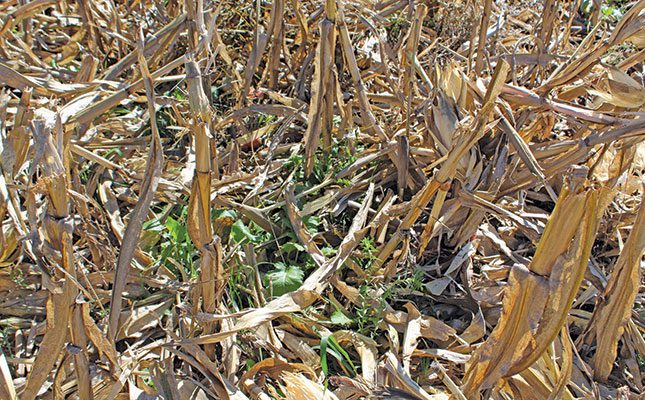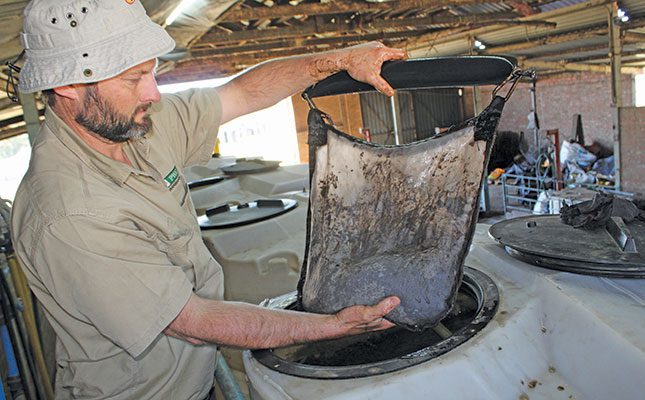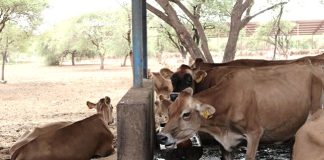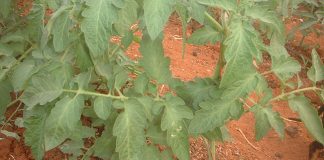
Photo: Lindi Botha
Soil so rich in nutrients that it feeds a crop without the need for additional inputs is any farmer’s dream. The state of South Africa’s soils after years of cultivation and chemicals has, however, rendered farms unable to produce anything without significant help from external, artificial sources.
No-till cultivation seeks to build soil health by increasing organic matter, boosting moisture retention and establishing enough earthworms to work the soil back to health. But as Hendrik Odendaal, a diversified crop and livestock farmer in Standerton, Mpumalanga, found, no-till can be problematic if the whole soil biome is not considered.
“The main driver for no-till is to build up carbon in the soil, thereby reducing erosion and input costs,” says Odendaal.
“Initially, the thinking was that by keeping crop residue on the land, and working it into the soil, the organic matter would increase. But this is not entirely the case. You can actually go backwards, and have more compaction and lower organic content, if you don’t manage the soil correctly.”

Odendaal converted the family farm’s crop division to no-till in 2007. He added significant amounts of compost made on the farm, planted cover crops and allowed cattle to graze the crop residue. But he was not seeing the results he wanted.
The organic content in the soil had increased, but he still required the same amount of fertiliser as before switching to no-till. Soya bean stands in particular fields were irregular, and pest and disease pressure remained unchanged, necessitating the standard application of crop protection chemicals.
Furthermore, the idea of building the biology below the surface, but still applying chemicals that reduced soil microbes, didn’t make sense.
Then, about three years ago, a seed sales rep told Odendaal about Hannes Botha in Carolina, who inoculated his seed before planting. Two weeks later, the crops were standing taller than those on any other farm.
Odendaal paid Botha a visit, and a whole new world of soil biology opened up to him. Botha suggested he do an online course, ‘The Soil Food Web’ by Dr Elaine Ingham, and implement the Johnson-Su compost bioreactor system Botha had on his farm.
“The course was expensive, but worth it. It completely shifted my thinking. I started understanding for the first time how soil and nutrient cycling work. No soil analyst had ever told me any of this, yet it’s something every farmer should know,” says Odendaal.
He has been making compost for 17 years, and spreading chicken manure on the crop fields for as long as he can remember. Yet, rather than help, it seemed to be part of the problem.
“Manure is high in bacteria, which breaks down organic matter. The more manure you add to a field, the higher the bacteria load, and the quicker plant material will break down, leaving hardly any carbon to build up the soil.
“Furthermore,” says Odendaal, “the high bacteria load is detrimental to other microbes and fungi that are crucial elements in healthy soils.”
When he analysed the microbe content in his fields, he realised there was hardly any fungi present. “Diversity is crucial when it comes to microbes: you need a good balance of different types of bacteria, fungi and protozoa to get real benefits,” he says.
Following Botha’s advice, Odendaal set up a series of Johnson-Su bioreactors.
These produce compost that does more than simply provide organic matter; they cultivate beneficial microbes, which increase overall soil health and function (see box).
Building a bioreactor
The system has changed the manure component that Odendaal adds to compost down from 50% to 10%.
“The mixture that goes into the bioreactor must consist of ‘browns’, ‘greens’ and ‘party food’,” he explains.
“The manure is the party food since it’s gobbled up quickly, and rapidly boosts growth of micro-organisms. Browns make up 60%. This consists of woodchips and fallen leaves. Greens make up the remaining 30% and consist of cut grass or hay.
“It’s not a difficult recipe, but you must be clear about what’s considered a brown or a green. Hay might be brown by the time it goes into the reactor, but it’s still a green, because it was green when you cut it. Determining whether something is a brown or a green depends on the carbon-to-nitrogen ratio, with a brown requiring a higher carbon component.
“Maize residues, for example, have a ratio of 80 parts carbon and one part nitrogen. Wood shavings will have a ratio of 600 parts carbon to one part nitrogen. Cut grass is 10 parts carbon and one part nitrogen. The ratio should be 30 parts carbon to one part nitrogen for a material to be considered a brown.”
Odendaal still produces conventional compost, spread in rows, but has reduced the amount from 800t/year to 150t/year. This compost has a greater balance between bacteria and fungi than previously, when it was manure-dominated.
Some 5t/year of compost is produced in the Johnson-Su bioreactors. This is kept for making slurry, which is sprayed in the furrow as the seeds are planted, and coats the seeds.
A compost tea extract is made that consists of bioreactor compost, conventional compost and vermicast to ensure maximum microbe diversity. The tea is applied to the fields several times a year.
Gas exchange
To reach optimum soil health, oxygen in the soil is key. Without tilling, micro-organisms fulfil this purpose. But for them to function at their optimum, they need food throughout the year. This is where cover crops play a crucial role in Odendaal’s recipe.
“The constant presence of plant material provides the micro-organisms with food. As they feed on the roots, they make nutrients in the soil available to the plant, while secreting oxygen,” he explains.
With so much effort put into keeping microbes thriving, limiting harmful chemicals is a necessary, but challenging, step.
Odendaal cautions that when you eliminate beneficial insects and microbes through pesticides and fungicides, soil can start to compact from the lack of subsurface activity.
“You have to sacrifice something in order to advance,” says Odendaal. “Every time you spray a pest, you kill a whole bunch of good organisms as well. My goal is to eliminate pesticides completely. For the past two years, I did not spray preventatively, only when infestation levels were above the threshold. This is determined by taking the age of the crop into consideration, as well as the infestation level and the amount of predators present in the field.”
Odendaal notes that controlling slugs is particularly difficult, since pesticides also kill the beetles that feed on the slugs. Slug resistance to pesticides is, however, growing, meaning the beetles face greater harm than the slugs.
To aid soil health and maintain living roots in the soil, Odendaal limits herbicide applications. By reducing row width from 91cm to 50,8cm, planted crops are better able to suppress weed growth due to a denser leaf canopy. This has eliminated one herbicide application for the season.
“You’ll never get the full benefit of the soil if you don’t stop fertilising,” says Odendaal. He explains that, when seeds are planted, they should not have any artificial growth stimulants around them, because this discourages them from growing to reach out into the soil biology. “The seed must be ‘motivated’ to go out and look for nutrients,” says Odendaal.
“When you add fertiliser right by the seed, the plant does not go looking any further for nutrients, and there is no exchange between the plant and biology.
“The gas exchange between microbes and plant roots does not take place, and the biology stagnates as it has no work to do.”
Optimal microbe-plant symbiosis ensures plants are guarded against diseases, says Odendaal. If this is out of balance, the crops have limited natural defence against pests and pathogens.
No-till practices often need increased nitrogen applications to compensate for the additional nitrogen required to break down the crop residues on the soil surface. When he started no-till, Odendaal increased his nitrogen applications by 20%.
Understanding the effect this had on the soil biology, however, led to him stopping the practice. He currently applies 20% less nitrogen than before he started no-till. No lime has been applied in the past two years, and no potassium or phosphates were applied during the past season.
Although Odendaal’s maize yield has dropped from 7t/ha to 5t/ha on dryland, the margins are better, and the future prospects look more promising. The farm has continued to keep up with long-term average yields for soya bean production in the area. This equates to 2t/ha on dryland and 3,8t/ha on irrigated fields.
Odendaal says that throughout this process, you can’t be looking over the fence to the conventional tillage farmer next door, trying to achieve the same gains.
“Going full no-till is a process, and during that process there are a lot of things you need to give up to get the full gain,” he says.
“With maize, for example, we used to plant a density of 80 000/ha. We would fertilise for 14t/ha and we would achieve that. But I realised that, for the benefit of soil biology, chasing high yields with high chemical fertiliser applications was simply not sustainable.”
As Odendaal says, there are so many aspects to successful no-till farming; it’s far more than just not tilling the soil.
Building a bioreactor
To build your own bioreactor, start by constructing a silo out of wire mesh. The silo should be around 2m high. Wrap cloth around the silo and fasten in place.
- You will need a wood or wire frame that will allow six PVC pipes to stand erect inside the silo. The silo should be placed on a wood pallet, or a plank with holes. Place the six PVC pipes in the frame to ensure the distance between each pipe is correct. The pipes are only in place temporarily and should be removed 24 hours after filling the bioreactor.
- Fungal hyphae in the bioreactor will hold open the channels where the pipes were, leaving open columns that let air flow up through the compost.
- To fill the bioreactor, a combination of material is needed that should consist of 30% animal manure, 30% shredded woodchips, and 30% leaves, grass or yard waste. Shredding these materials increases the surface area, which will ensure a quicker degradation by the microbes. It is recommended to fill the bioreactor in one go so that internal temperature can be monitored for the next four to five days to ensure an adequate breakdown of materials.
- Before beginning to fill the bioreactor, it is crucial to completely wet the feed materials. Add material to a bucket or tank of water, and after a few minutes squeeze out excess water before dumping the wet material into the silo, below the frame, since the frame needs to be removed to use in the next silo. Do not press down on the materials. There needs to be aerobic conditions so that the compost is full of good bacteria and fungal life.
- Keep the silo moist. Install an irrigation system to keep the pile adequately damp (greater than 70% moisture content), but not so wet that anaerobic conditions are created. Test moisture levels by squeezing a handful of material. It should be able to produce a drop or two, no more. Keep the pile covered to keep the compost moist.
- For the first five days after filling the bioreactor, measure the temperature of the pile. The temperature should be in the range of 60°C to 74°C. Once the pile temperature drops below 26°C, earthworms can be added to boost the composting process. Feed materials should be composted in the bioreactor for at least nine months. A one-year composting period is recommended since microbial populations and species richness increase significantly at about the one-year threshold.
Sources: fifthseasongardening.com and Hendrik Odendaal.
Email Hendrik Odendaal at [email protected].










